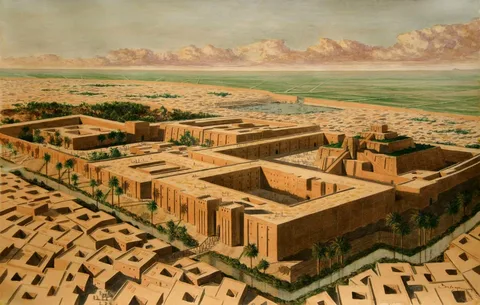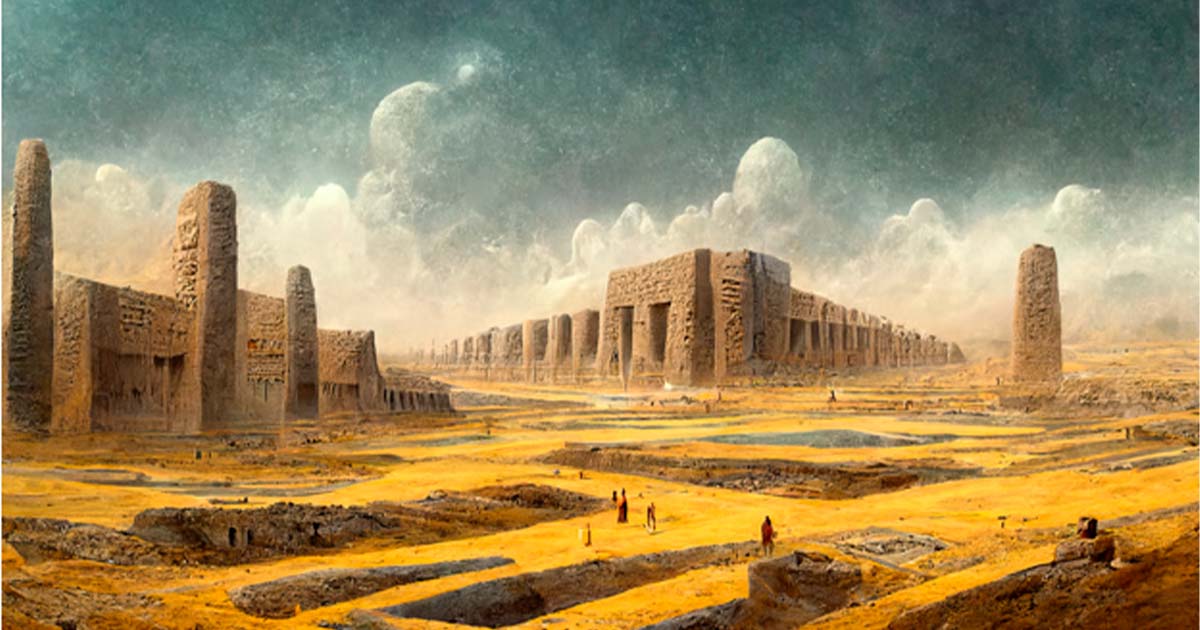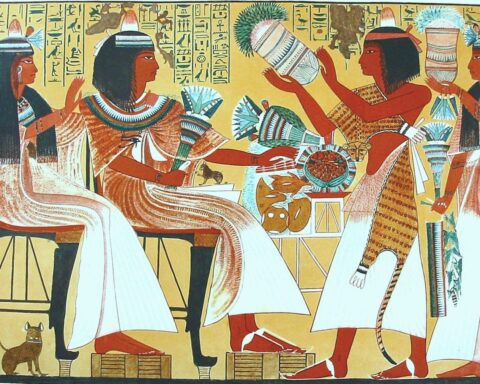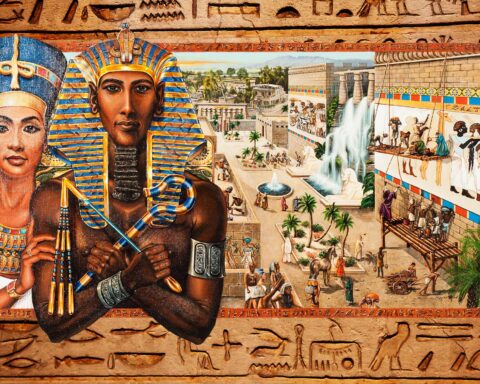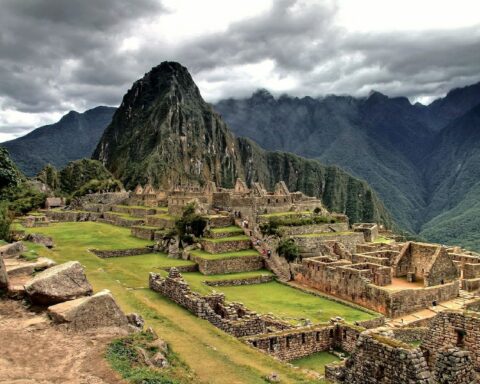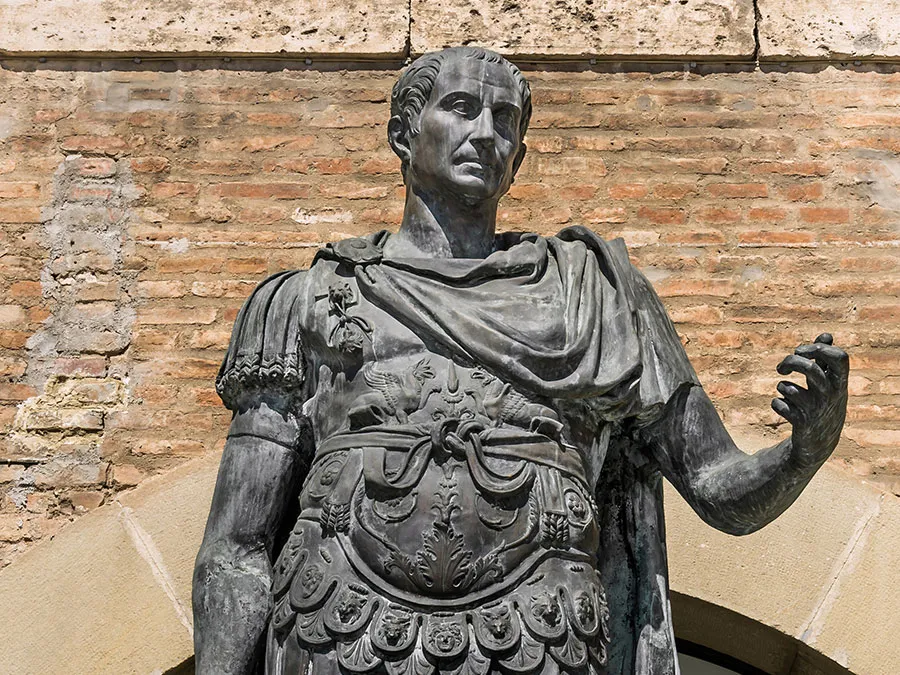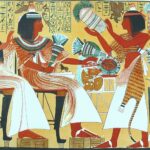The Sumerian City-States
Early Development and Formation
The ancient Sumerians were a civilization that flourished in Mesopotamia, which is now modern-day Iraq, around 4500-1900 BCE. They are considered one of the earliest urban civilizations on Earth and are often referred to as the “cradle of civilization”.
The name “Sumer” was first used by the Greeks to describe the region inhabited by these early people. The Sumerians themselves called their city-states “ki,” which means “city” or “land.” Over time, the name “Sumer” became synonymous with the entire region.
Geographically, Mesopotamia is located in the Fertile Crescent, a fertile region that lies between the Tigris and Euphrates rivers. This area offered ideal conditions for early agriculture, including abundant water supply, fertile soil, and a mild climate.
The Sumerians developed complex city-states, each with its own system of government, economy, and culture. These cities included Ur, Uruk, Lagash, and Nippur, among others. Each city-state was ruled by a king or governor who was often seen as divine.
One of the most significant contributions of the Sumerians to modern society was their invention of writing, known as cuneiform. This complex system of wedge-shaped symbols allowed them to record laws, business transactions, and literary works. The Epic of Gilgamesh, which is considered one of the earliest surviving works of literature, was written in cuneiform.
The Sumerians also made significant advances in mathematics, astronomy, and engineering. They developed a sexagesimal (base-60) number system that is still used today for measuring time and angles. They also created sophisticated irrigation systems, which allowed them to control the flow of water and increase agricultural productivity.
Religion played a central role in Sumerian society, with many different gods and goddesses worshipped by different city-states. The most important deity was Enlil, the god of air and storms, who was often depicted as a powerful ruler.
The Sumerians had a complex social hierarchy, with kings and nobles at the top, followed by priests, merchants, artisans, and laborers. Women played an important role in Sumerian society, serving as priestesses, merchants, and even rulers.
In terms of their culture and traditions, the Sumerians were known for their love of music, dance, and storytelling. They also developed a complex system of mythology, which included stories about creation, floods, and great heroes.
The fall of the Sumerian civilization was due to a combination of factors, including climate change, droughts, and invasions by neighboring tribes. The last Sumerian city-state fell around 1900 BCE, marking the end of this ancient civilization.
The Sumerians established citystates in Mesopotamia, which is now modernday Iraq. Each citystate was governed by its own ruler or king.
The Sumerians were an ancient civilization that flourished in Mesopotamia, which is now modern-day Iraq. They are often referred to as one of the earliest urban civilizations in the world.
They established a number of city-states in Mesopotamia, each governed by its own ruler or king. These city-states were typically surrounded by walls and had their own governments, laws, and systems of administration.
The most famous Sumerian city-states include Ur, Uruk, Nippur, Lagash, and Kish. Each of these cities had its own unique culture and traditions, but they also shared many common characteristics.
The Sumerians are perhaps best known for their contributions to the development of writing. They invented a system of writing that used clay tablets and reed pens, which allowed them to record laws, business transactions, and even literature.
This writing system, known as cuneiform, was a major breakthrough in human communication and paved the way for the development of more complex societies. The Sumerians also made significant contributions to mathematics, astronomy, and architecture.
The city-states of Mesopotamia were often at odds with one another, and warfare was common between them. However, they also traded and exchanged goods with one another, which helped to promote economic growth and cultural exchange.
In addition to their many achievements in politics, writing, and commerce, the Sumerians were skilled craftsmen who produced beautiful works of art, including sculptures, pottery, and jewelry.
The Sumerian civilization began to decline around 2000 BC, but its legacy continued to influence subsequent civilizations in Mesopotamia. The Akkadians, Babylonians, and Assyrians all built on the foundations laid by the Sumerians and eventually replaced them as the dominant power in the region.
Today, we can learn much about the Sumerians from the many artifacts that have been discovered in Mesopotamia. These include not only clay tablets with cuneiform writing but also a wide range of archaeological materials such as pottery, tools, and architecture.
The study of the Sumerians provides valuable insights into human history and culture, and it continues to be an important area of research for archaeologists, historians, and anthropologists alike.
City-State Governance
The ancient Sumerians are considered one of the earliest civilizations on Earth, with their city-states emerging around 4500-1900 BCE in Mesopotamia (present-day Iraq).
The Sumerian civilization was characterized by a complex system of governance, known as City-State Governance, where multiple cities were ruled independently but shared cultural and linguistic ties.
Each Sumerian city-state, such as Ur, Uruk, Nippur, and Lagash, had its own government, laws, and administrative systems, but they often interacted and traded with one another.
The City-State Governance system allowed for the development of specialized labor, trade, and cultural exchange among the Sumerians, contributing to their rapid growth and advancement.
At the heart of each city-state was a temple complex that served as the center of worship, education, and governance, with its priestly class holding significant power and influence.
The temples also stored large archives of clay tablets containing written records of laws, business transactions, literature, and historical events, which were essential for maintaining order and stability in the city-state.
City-states like Lagash and Uruk developed distinct systems of governance, with Lagash adopting a more centralized power structure under its ruler, Gudea, while Uruk’s leadership was characterized by a loose network of rulers and nobles.
The Sumerians made significant contributions to the development of writing (cuneiform), law codes (e.g., Hammurabi’s Code), and governance systems, which later influenced other civilizations in Mesopotamia and beyond.
Despite their cultural achievements, the city-states of ancient Sumeria eventually fell to external powers or merged with neighboring city-states, but their legacy continued to shape the course of history in Mesopotamia for centuries to come.
These citystates were often at odds with one another, leading to frequent wars over resources and territory.
The ancient Sumerians lived in city-states known as Mesopotamia, which is located between the Tigris and Euphrates rivers. They were one of the earliest civilizations in history, with a culture that thrived around 4500-1900 BCE.
Mesopotamia was not a single, unified state, but rather a collection of city-states that often clashed with one another. The most notable city-states included Ur, Uruk, Nippur, Lagash, and Kish.
The Sumerians were skilled farmers who cultivated crops such as barley, wheat, and dates in the fertile plains between the rivers. They also developed sophisticated irrigation systems to support their agriculture.
Despite their agricultural advancements, the Sumerians often found themselves at odds with neighboring city-states over resources and territory. These conflicts led to frequent wars, which were usually fought by armies of infantrymen armed with copper-headed spears.
The Sumerians developed a system of governance known as the “city-state,” where each city was ruled by a council of elders or a single ruler who held absolute power. They also created a system of writing, known as cuneiform, which consisted of wedge-shaped symbols inscribed on clay tablets.
Notable Sumerian City-States
- Ur: Known for its rich copper deposits and the famous Ziggurat temple complex, Ur was one of the largest city-states in Mesopotamia.
- Uruk: Founded by King Gilgamesh, Uruk was a major center of Sumerian culture and learning. The Epic of Gilgamesh, one of the earliest surviving works of literature, originated from this city-state.
- Nippur: A sacred city in the Sumerian pantheon, Nippur was home to several important temples dedicated to the god Enlil.
- Lagash: Known for its impressive military campaigns and extensive irrigation systems, Lagash was a major power in Mesopotamia during the Early Dynastic Period.
- Kish: Located near present-day Baghdad, Kish was an important center of trade and commerce, with connections to neighboring city-states and civilizations.
The ancient Sumerians made significant contributions to human civilization, including the invention of writing, the development of cities, and the creation of sophisticated irrigation systems. Their legacy continues to inspire and influence modern society today.
Sumerian Contributions to Civilization
Writing System Development
The ancient Sumerians are considered one of the oldest civilizations on earth, dating back to around 4500 BC. They lived in Mesopotamia, which is modern-day Iraq.
The Sumerian writing system is known as cuneiform, which is characterized by wedge-shaped marks inscribed into clay tablets using a reed stylus.
Cuneiform writing emerged around 3200 BC and was used for over three thousand years. It was written from top to bottom and consisted of over 600 symbols, including logograms (symbols representing words or concepts), phonetic signs (representing sounds), and determinatives (helping to disambiguate the meaning of a word).
The cuneiform writing system went through several stages of development, with different types of cuneiform emerging during different periods. The earliest type was called archaic cuneiform, which was used during the Early Dynastic period and was more pictorial in nature.
As time passed, cuneiform became a more sophisticated and abstract writing system. During the Old Babylonian period (1834-1531 BC), cuneiform evolved into a phonetic-based system, with symbols representing distinct sounds rather than concepts or objects.
The Sumerians also made significant contributions to the development of mathematics, law codes, and literature. They developed sexagesimal (base-60) arithmetic and used it for counting and timekeeping. Their law code, known as the Code of Ur-Nammu, is one of the oldest known written codes of laws.
The Sumerians were a highly literate society, with most city-states maintaining extensive archives of clay tablets containing business transactions, literary works, and administrative records.
Some notable examples of Sumerian literature include the Epic of Gilgamesh, one of the earliest surviving works of literature, and the Descent of Inanna, which tells the story of a goddess’s journey to the underworld.
The study of ancient Mesopotamia, particularly the Sumerians, has greatly expanded our understanding of human civilization, from its origins in agriculture and cities to its development of complex writing systems and governance structures.
The Sumerians are credited with developing the first writing system, known as cuneiform, which allowed for more complex communication.
The ancient Sumerians were a civilization that thrived in Mesopotamia, located between the Tigris and Euphrates rivers in what is now modern-day Iraq. They are widely regarded as one of the most influential cultures in human history.
The name “Sumerian” is derived from the term “Shumer,” which was used by the Akkadians to refer to the southern part of Mesopotamia, where the Sumerians lived. The Sumerians called themselves “Shu-mers,” which means “those who live at the left bank” or simply “people.”
The Sumerians were a highly developed and sophisticated people, with their own system of writing (cuneiform), a complex system of government, and impressive architectural achievements. They are known for building some of the oldest cities in the world, including Ur, Nippur, and Uruk.
Geographically, Mesopotamia was an ideal place for human settlement due to its fertile soil, abundant water supply, and favorable climate. The Sumerians took full advantage of this natural resource, cultivating crops such as barley, wheat, and dates, and developing advanced irrigation systems to support their agriculture.
The Sumerians are often credited with inventing the wheel, which revolutionized transportation and commerce. They also made significant contributions to mathematics, astronomy, and medicine. Their innovations and achievements had a profound impact on the development of human civilization as we know it today.
The Sumerian city-states were typically small, ranging from 10,000 to 50,000 inhabitants. The largest city-state was Uruk, which covered an area of approximately 20 square miles. These cities were often surrounded by walls and featured impressive temples, palaces, and other architectural monuments.
The Sumerians developed a complex system of government, with each city-state having its own ruler or king. The kings often claimed divine ancestry, and their reigns were marked by grand architectural projects and military campaigns to expand their territories.
Unfortunately, the Sumerian civilization declined around 1900 BCE due to a combination of factors, including climate change, soil degradation, and internal conflicts. However, their legacy lived on through the Babylonians, Assyrians, and other cultures that followed in Mesopotamia.
The Sumerians’ contributions to human history are immeasurable, and their impact can still be felt today in our language, architecture, governance, and technology. They were a truly remarkable civilization that set the stage for the development of Western culture as we know it.
Mathematical and Astronomical Achievements
- The ancient Sumerians are considered one of the most significant civilizations of antiquity, making profound contributions to various fields including mathematics and astronomy.
- Geographically, they inhabited the region between the Tigris and Euphrates rivers in Mesopotamia, which is present-day Iraq.
- Mathematically, they made substantial achievements that laid the foundation for future mathematical developments in ancient civilizations.
- The Sumerians were the first to develop a sexagesimal (base 60) number system, which we still use today in terms of time (e.g., minutes and seconds).
- They also invented a positional notation system for writing numbers, where each position represented a power of sixty.
- This innovative system allowed them to accurately calculate areas, volumes of pyramids and cones, and even solve quadratic equations.
- Astronomically, the Sumerians demonstrated remarkable understanding of celestial phenomena and recorded observations that have withstood the test of time.
- They accurately measured the duration of the year as 365 days, recognizing a quarter-day error that would not be corrected until thousands of years later.
- The Sumerian king, Sin-kashid, is credited with observing and recording the first solar eclipse in recorded history around 2130 BCE.
- Their star catalog contained over 100 entries, many of which still correspond to actual stars or constellations recognizable today.
- These impressive achievements are a testament to the ingenuity and intellectual curiosity of the ancient Sumerians.
The Sumerians made significant contributions to mathematics, including the development of arithmetic and geometric calculations. They also observed the stars and developed a sexagesimal (base60) system that is still in use today.
The Sumerians were an ancient civilization that flourished in Mesopotamia, which is now modern-day Iraq, around 4500 years ago. They are considered one of the most important civilizations of the ancient world and made significant contributions to various fields, including mathematics.
One of the most notable mathematical achievements of the Sumerians was the development of arithmetic calculations. They used a sexagesimal (base-60) system that allowed them to perform complex calculations with ease. This system is still in use today for measuring time and angles in astronomy, as well as for representing geographical coordinates.
The Sumerians also made significant contributions to geometry, including the development of basic geometric shapes such as triangles, quadrilaterals, and polygons. They used these shapes to calculate areas and volumes of various objects, which was crucial for architectural and engineering purposes.
In addition to their mathematical achievements, the Sumerians were skilled astronomers who observed the stars and developed a sophisticated understanding of astronomy. They identified 36 constellations in the night sky and used them to create a calendar that was based on lunar cycles.
The sexagesimal system developed by the Sumerians is still in use today for measuring time and angles in astronomy, as well as for representing geographical coordinates. This system has been adopted by many cultures around the world and remains an important part of modern mathematics and science.
The contributions of the Sumerians to mathematics and science are a testament to their ingenuity and creativity. Their development of arithmetic and geometric calculations laid the foundation for many mathematical discoveries that followed in later civilizations, while their understanding of astronomy helped to shape our understanding of the universe.
Sumerian Daily Life
Food and Drink
The ancient Sumerians were one of the earliest known civilizations, emerging around 4500 BCE in Mesopotamia (modern-day Iraq). They lived along the fertile plains between the Tigris and Euphrates rivers, which provided an ideal environment for agriculture.
Food was a staple of Sumerian life, with the majority relying on agriculture to grow crops such as barley, wheat, dates, and vegetables. They also raised animals like sheep, goats, and cattle for meat, dairy products, and clothing. The Sumerians were skilled farmers, using advanced irrigation systems to support their crops.
The Sumerians were also known for their love of beer. Beer was a staple beverage in ancient Mesopotamia, made from fermented barley or dates. It was often cloudy and had a strong flavor. The Sumerians even created a standardized system of weights and measures to ensure that beer was produced consistently.
The ancient Sumerians also enjoyed a variety of foods, including:
- Dried fruits like dates, figs, and raisins.
- Nuts like almonds and pistachios.
- Fish from the rivers and streams.
- Game meat like deer and wild boar.
- Vegetables like onions, garlic, and cucumbers.
The Sumerians were also skilled bakers, using advanced techniques to create bread from their grains. They even created a standardized system of weights and measures to ensure that bread was produced consistently.
Drink options for the ancient Sumerians included:
- Beer, made from fermented barley or dates.
- Water from wells and springs.
- Milk from domesticated animals.
- Wine was not common in ancient Mesopotamia, but it did exist.
The ancient Sumerians’ diet was heavily influenced by their social status. The wealthy had access to a wider variety of foods, including meat and dairy products. The poor, on the other hand, relied mainly on barley bread and vegetables.
The Sumerians ate a diet rich in grains, fruits, and vegetables. Beer was a staple drink for both men and women.
The ancient Sumerians were one of the earliest civilizations to exist on Earth, living around 4500-1900 BCE in Mesopotamia, which is now modern-day Iraq.
This region was known as the “cradle of civilization” due to its fertile land between two great rivers, the Tigris and Euphrates. The Sumerians were skilled farmers who cultivated grains such as barley and wheat, as well as dates and figs, which provided a rich source of food and nutrients.
Their diet was also supplemented with vegetables, fruits, and other crops that grew in the region. One of their most valuable resources, however, was beer, which was brewed from fermented barley and served to both men and women.
Beer played an important role in Sumerian culture, not only as a refreshing drink but also as a form of currency and even as a way to settle debts. The Sumerians believed that the goddess Ninkasi had created beer, which was considered a gift from the gods.
The ancient Sumerians were known for their advanced knowledge of mathematics and astronomy, which they used to develop a system of writing that included cuneiform script. They also developed a system of governance with city-states ruled by kings and queens who maintained temples dedicated to various deities.
Some of the most notable achievements of the Sumerians include:
- Developing the first system of writing, which allowed them to record laws, myths, and historical events
- Creating sophisticated irrigation systems that allowed for agricultural growth in a region with limited water resources
- Building advanced cities with temples, palaces, and public buildings that showcased their architectural skills
- Developing a system of governance with city-states ruled by kings and queens who maintained the peace and order in their respective territories
In summary, the ancient Sumerians were a remarkable civilization that made significant contributions to human history in fields such as agriculture, writing, mathematics, astronomy, architecture, and governance.
Home and Family
The Ancient Sumerians were one of the earliest civilizations to exist on Earth, with a rich culture and history that dates back around 4500 years. They lived in Mesopotamia, which is now modern-day Iraq, Kuwait, and parts of Syria, Turkey, and Iran.
Sumerian City-States were the core of their society, with each city-state being a separate entity with its own government and rulers. The most prominent Sumerian cities include Ur, Uruk, Lagash, Nippur, Kish, and Shuruppak.
The Sumerians were skilled farmers, growing crops such as barley, wheat, and dates, which they used to produce a variety of goods. They also raised animals like sheep, goats, and cattle for food, clothing, and milk.
Sumerian Family Life was highly organized and patriarchal, with the head of the household being the father or oldest male relative. The family lived in multi-story homes made of mud bricks, which were often decorated with intricate frescoes and murals.
The Sumerians believed in a complex pantheon of gods, with over 500 deities worshipped throughout their history. Their most important god was Anu, the sky god, who was considered to be the supreme deity. Other notable Sumerian gods include Enlil (air), Enki (water), and Inanna (love).
Sumerians were known for their literary achievements, including the creation of epic poems, hymns, and other written works. Their literature was often recorded on clay tablets using cuneiform script.
Here are some key characteristics of Sumerian society:
- Civilizations: They were one of the earliest civilizations to exist, with a complex system of city-states and government.
- Farming and agriculture: They developed advanced irrigation systems and farming techniques, allowing them to produce surplus crops.
- Writing and literature: They created cuneiform script and wrote epic poems, hymns, and other literary works.
- Patriarchal society: Sumerian family life was highly organized around the father or oldest male relative.
- Complex pantheon of gods: They believed in over 500 deities worshipped throughout their history, with a complex system of myth and legend.
In conclusion, the Ancient Sumerians were a highly advanced civilization that made significant contributions to human society. Their achievements in farming, writing, literature, and governance continue to influence modern-day cultures around the world.
Sumerian homes were typically made of mud brick and featured multiple rooms. They valued family and social ties.
The ancient Sumerians were a civilization that lived in Mesopotamia, which is now modern-day Iraq. They are considered one of the earliest urban civilizations and made significant contributions to many fields such as writing, government, architecture, and law.
They lived in the southern part of Mesopotamia, between the Tigris and Euphrates rivers, from around 4500 to 1900 BCE. The Sumerians were polytheistic and worshiped a variety of gods and goddesses associated with nature and human activities.
Their homes were typically made of mud brick and featured multiple rooms, including a central courtyard where families would gather for meals and socializing. These homes also had separate areas for sleeping, cooking, and storage.
The Sumerians valued family and social ties highly. They believed in the importance of kinship and extended family relationships. Marriages were often arranged within the same social class or between different noble families to strengthen alliances and secure trade agreements.
They also had a strong sense of community, with people coming together for various festivals and celebrations throughout the year. Some notable Sumerian festivals include the Akitu festival, which celebrated the fertility of the land, and the Festival of Enlil, which honored the patron god of the city of Nippur.
Education was also highly valued in Sumerian society, with scribes trained to write on clay tablets using cuneiform script. The most famous of these scribes is believed to be Enheduanna, a high priestess who served under the rule of King Shulgi and wrote hymns and poems that still exist today.
The Sumerians are also credited with making significant advances in law and governance, including creating one of the earliest forms of written laws. These codes were designed to promote social order and justice among the population.
Some notable Sumerian cities include Ur, Uruk, Nippur, and Eridu. Each of these cities had its own unique culture, architecture, and contributions to Sumerian society.
The legacy of the Sumerians can be seen in many aspects of modern life, from language (Sumerian is an isolate language, meaning it has no known relatives) to writing systems, which were adopted by other civilizations such as the Akkadians and Babylonians. The Sumerians’ innovative use of mud brick architecture also influenced building techniques throughout history.
Sumerian Society and Economy
Economic Systems
The ancient Sumerians were one of the earliest civilizations to develop a complex economic system. They lived in Mesopotamia, which is modern-day Iraq and parts of Syria, Turkey, and Iran.
In the early days, the economy was primarily based on bartering, where people traded goods and services directly without using money. However, as the Sumerian civilization grew and became more complex, a system of exchange called commodity-based money emerged.
The Sumerians used commodities like grains, oil, and dates as currency. They also developed a system of standardized weights and measures to facilitate trade. For example, they used the “shekel” as a unit of account for precious metals and other valuable goods.
As the economy continued to grow and evolve, the Sumerians developed a concept called the “entitlement principle,” which stated that an individual’s economic position was determined by their birth or social status. This led to the emergence of social classes and the concentration of wealth in the hands of a few individuals.
One of the most significant innovations of the Sumerian economy was the development of trade with other civilizations. They traded goods like textiles, metals, and foodstuffs across vast distances using merchant ships and caravans.
The Sumerians also developed sophisticated systems for recording economic transactions, including the use of clay tablets inscribed with cuneiform script. These records allowed them to track taxes, debts, and other financial obligations over time.
Despite its many innovations, the Sumerian economy was not without its challenges. The country suffered from frequent wars, droughts, and famines, which disrupted trade and commerce. Additionally, social inequality led to tensions between the wealthy elite and the poor masses.
The legacy of the Sumerian economic system can be seen in the modern economies that followed it. Many of their innovations, such as commodity-based money and standardized weights and measures, were adopted by later civilizations.
However, the Sumerians also laid the groundwork for more complex economic systems that would emerge in the future, including the development of capital markets, corporations, and the concept of profit maximization.
In conclusion, the ancient Sumerian civilization played a significant role in shaping the course of human economic history. Their innovative use of commodity-based money, trade networks, and record-keeping systems laid the foundation for more complex economies to emerge later on.
The Sumerians developed a complex system of trade, with cities exchanging goods such as grains, textiles, and metals.
The Sumerians were an ancient civilization that lived in Mesopotamia, which is now modern-day Iraq, from around 4500 to 1900 BCE. They are considered one of the earliest urban civilizations and made significant contributions to the development of writing, governance, architecture, and technology.
Geographically, Sumer was a region in southern Mesopotamia that encompassed several city-states, including Ur, Uruk, Nippur, Lagash, and Kish. These city-states were often at odds with one another, but they also shared a common culture and language.
The Sumerians developed a complex system of writing known as cuneiform, which was used for business transactions, literature, and governance. This writing system consisted of wedge-shaped characters inscribed on clay tablets with a reed stylus.
Cuneiform writing allowed the Sumerians to record laws, trade agreements, and stories. Some famous Sumerian texts include the Epic of Gilgamesh, which is one of the earliest surviving works of literature, and the Code of Ur-Nammu, which is one of the oldest known law codes.
The Sumerians also developed a system of governance that consisted of city-states ruled by kings. These kings were responsible for maintaining law and order, collecting taxes, and overseeing trade and commerce.
One of the most notable Sumerian leaders was Gilgamesh, who ruled the city-state of Uruk in the Early Dynastic Period (c. 2600 BCE). He is famous for his quest for immortality and his friendship with Enkidu, a wild man created by the gods.
The Sumerians made significant contributions to architecture, including the development of the ziggurat, a stepped pyramid temple complex dedicated to the chief deity of the city. The most famous example of a ziggurat is the one built at Ur, which was constructed during the Third Dynasty of Ur (c. 2100 BCE).
The Sumerians also developed advanced irrigation systems that allowed them to farm the fertile plains of Mesopotamia. These irrigation systems consisted of canals, dams, and dykes that were built to control the flow of water and prevent flooding.
Slavery and Social Hierarchy
The concept of slavery and social hierarchy is not unique to any particular culture or time period, but one ancient civilization that exemplified these systems was the Ancient Sumerians.
The Sumerians lived in Mesopotamia, which is now modern-day Iraq, from around 4500 to 1900 BCE. They are considered one of the earliest urban civilizations and made significant contributions to law, governance, architecture, and writing.
However, beneath the surface of their impressive achievements lay a complex social hierarchy that included slaves, free laborers, priests, nobles, and kings. Slavery was an integral part of Sumerian society, with enslaved people working on temples, palaces, and estates for the ruling elite.
The Sumerians practiced a system of slavery known as “debt-slavery,” where individuals who were unable to pay their debts could be forced into servitude. This often involved being sold or given away to another family or noble, perpetuating a cycle of dependence.
Free laborers, on the other hand, made up the majority of the Sumerian population. They worked as farmers, artisans, and merchants but did not have access to the same social status and privileges as the nobility.
The Sumerians also had a class of temple slaves known as “ensi,” who were responsible for managing temple estates, collecting taxes, and performing rituals. These individuals held significant power within their communities and often wielded more influence than some of the ruling nobles.
Ancient Sumerian social hierarchy was largely determined by birth and occupation. The nobility consisted of kings, princes, and high-ranking officials who controlled much of the land, resources, and labor. Below them were priests, judges, and other influential individuals who played key roles in maintaining order and upholding Sumerian traditions.
The majority of society, however, comprised free laborers and slaves who worked tirelessly to maintain the economic and social structures of their community. It is essential to note that the Ancient Sumerians did have a relatively advanced system for social mobility compared to other ancient civilizations.
Individuals could rise through the ranks by demonstrating exceptional skills or accumulating wealth, although such advancements were often dependent on patronage from nobles or high-ranking officials. Nonetheless, these opportunities for advancement and social mobility reflect a more complex and nuanced Sumerian society than might be expected based solely on their ancient reputation as pioneers of civilization.
While slavery existed in Sumeria, it is believed that only a small percentage of the population was enslaved. Society was also divided into distinct classes, with kings and nobles at the top.
The ancient Sumerians were a civilization that lived in Mesopotamia, which is now modern-day Iraq, from around 4500 to 1900 BCE.
They are considered one of the earliest urban civilizations and are often referred to as the cradle of civilization due to their significant contributions to society, including the development of writing, governance, and architecture.
The Sumerians were known for their advanced knowledge of mathematics, astronomy, and medicine. They developed a sexagesimal (base-60) number system that is still used today for measuring time and angles.
They also made significant contributions to the fields of law, business, and architecture. The Code of Ur-Nammu, which was discovered in the 19th century, is one of the earliest known examples of a written code of law.
The Sumerians were polytheistic, believing in a pantheon of gods and goddesses that controlled various aspects of life, such as fertility, war, and the harvest. Their most important deity was Enlil, who was considered the king of the gods.
Sumerian society was divided into distinct classes, with kings and nobles at the top. These individuals held significant power and influence, but they were also responsible for maintaining the social order and upholding the laws.
Beneath the nobility were the free commoners, who made up the majority of the population. They worked as farmers, craftsmen, and merchants, and played an essential role in the functioning of society.
At the bottom of the social hierarchy were the slaves, who were often prisoners of war or individuals who had been sold into bondage by their families. While slavery existed in Sumeria, it is believed that only a small percentage of the population was enslaved.
The Sumerians were skilled craftsmen and developed advanced techniques for working with metals, such as copper and bronze. They also made significant contributions to the development of irrigation systems and urban planning.
The city-states of ancient Sumeria were often at odds with one another, leading to a series of wars and conflicts throughout history. However, they also maintained a network of trade and cultural exchange that facilitated the spread of ideas and innovations.
- 10 Most Beautiful Ozark Mountain Towns - September 3, 2024
- Countries That Start With The Letter Q - September 3, 2024
- 10 Largest Cities In Nebraska - September 2, 2024

